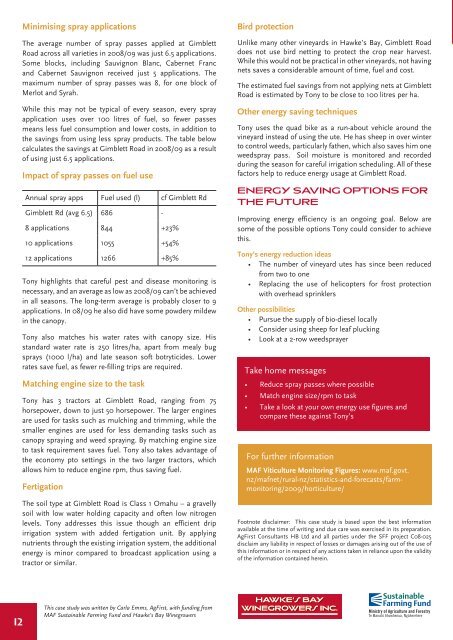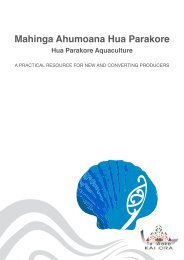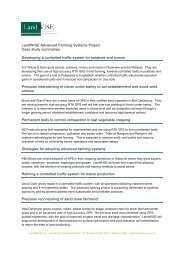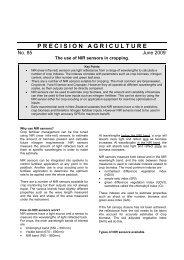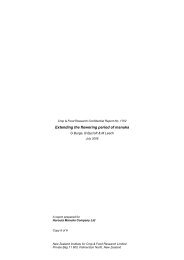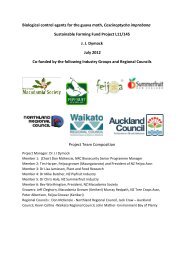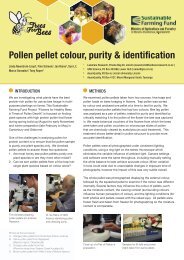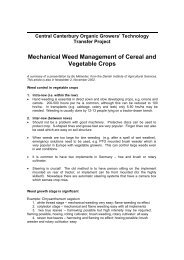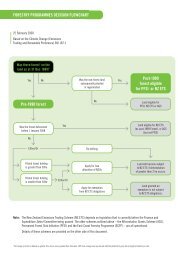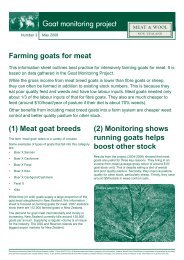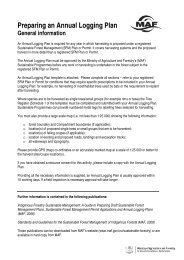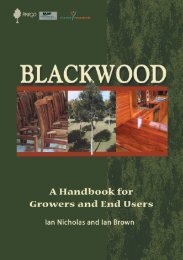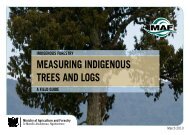Hawkes Bay Winegrowers Booklet
Hawkes Bay Winegrowers Booklet
Hawkes Bay Winegrowers Booklet
Create successful ePaper yourself
Turn your PDF publications into a flip-book with our unique Google optimized e-Paper software.
Minimising spray applications<br />
The average number of spray passes applied at Gimblett<br />
Road across all varieties in 2008/09 was just 6.5 applications.<br />
Some blocks, including Sauvignon Blanc, Cabernet Franc<br />
and Cabernet Sauvignon received just 5 applications. The<br />
maximum number of spray passes was 8, for one block of<br />
Merlot and Syrah.<br />
While this may not be typical of every season, every spray<br />
application uses over 100 litres of fuel, so fewer passes<br />
means less fuel consumption and lower costs, in addition to<br />
the savings from using less spray products. The table below<br />
calculates the savings at Gimblett Road in 2008/09 as a result<br />
of using just 6.5 applications.<br />
Impact of spray passes on fuel use<br />
Annual spray apps Fuel used (l) cf Gimblett Rd<br />
Gimblett Rd (avg 6.5) 686 -<br />
8 applications 844 +23%<br />
10 applications 1055 +54%<br />
12 applications 1266 +85%<br />
Tony highlights that careful pest and disease monitoring is<br />
necessary, and an average as low as 2008/09 can’t be achieved<br />
in all seasons. The long-term average is probably closer to 9<br />
applications. In 08/09 he also did have some powdery mildew<br />
in the canopy.<br />
Tony also matches his water rates with canopy size. His<br />
standard water rate is 250 litres/ha, apart from mealy bug<br />
sprays (1000 l/ha) and late season soft botryticides. Lower<br />
rates save fuel, as fewer re-filling trips are required.<br />
Matching engine size to the task<br />
Tony has 3 tractors at Gimblett Road, ranging from 75<br />
horsepower, down to just 50 horsepower. The larger engines<br />
are used for tasks such as mulching and trimming, while the<br />
smaller engines are used for less demanding tasks such as<br />
canopy spraying and weed spraying. By matching engine size<br />
to task requirement saves fuel. Tony also takes advantage of<br />
the economy pto settings in the two larger tractors, which<br />
allows him to reduce engine rpm, thus saving fuel.<br />
Fertigation<br />
The soil type at Gimblett Road is Class 1 Omahu – a gravelly<br />
soil with low water holding capacity and often low nitrogen<br />
levels. Tony addresses this issue though an efficient drip<br />
irrigation system with added fertigation unit. By applying<br />
nutrients through the existing irrigation system, the additional<br />
energy is minor compared to broadcast application using a<br />
tractor or similar.<br />
Bird protection<br />
Unlike many other vineyards in Hawke’s <strong>Bay</strong>, Gimblett Road<br />
does not use bird netting to protect the crop near harvest.<br />
While this would not be practical in other vineyards, not having<br />
nets saves a considerable amount of time, fuel and cost.<br />
The estimated fuel savings from not applying nets at Gimblett<br />
Road is estimated by Tony to be close to 100 litres per ha.<br />
Other energy saving techniques<br />
Tony uses the quad bike as a run-about vehicle around the<br />
vineyard instead of using the ute. He has sheep in over winter<br />
to control weeds, particularly fathen, which also saves him one<br />
weedspray pass. Soil moisture is monitored and recorded<br />
during the season for careful irrigation scheduling. All of these<br />
factors help to reduce energy usage at Gimblett Road.<br />
ENERGY SAVING OPTIONS FOR<br />
THE FUTURE<br />
Improving energy efficiency is an ongoing goal. Below are<br />
some of the possible options Tony could consider to achieve<br />
this.<br />
Tony’s energy reduction ideas<br />
• The number of vineyard utes has since been reduced<br />
from two to one<br />
• Replacing the use of helicopters for frost protection<br />
with overhead sprinklers<br />
Other possibilities<br />
• Pursue the supply of bio-diesel locally<br />
• Consider using sheep for leaf plucking<br />
• Look at a 2-row weedsprayer<br />
Take home messages<br />
• Reduce spray passes where possible<br />
• Match engine size/rpm to task<br />
• Take a look at your own energy use figures and<br />
compare these against Tony’s<br />
For further information<br />
MAF Viticulture Monitoring Figures: www.maf.govt.<br />
nz/mafnet/rural-nz/statistics-and-forecasts/farmmonitoring/2009/horticulture/<br />
Footnote disclaimer: This case study is based upon the best information<br />
available at the time of writing and due care was exercised in its preparation.<br />
AgFirst Consultants HB Ltd and all parties under the SFF project C08-025<br />
disclaim any liability in respect of losses or damages arising out of the use of<br />
this information or in respect of any actions taken in reliance upon the validity<br />
of the information contained herein.<br />
16 12<br />
This case study was written by Carla Emms, AgFirst, with funding from<br />
MAF Sustainable Farming Fund and Hawke’s <strong>Bay</strong> <strong>Winegrowers</strong><br />
HAWKE’S BAY<br />
WINEGROWERS INC.


